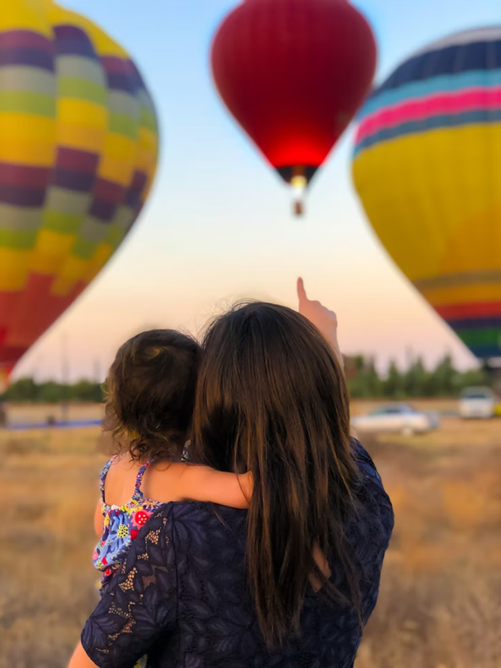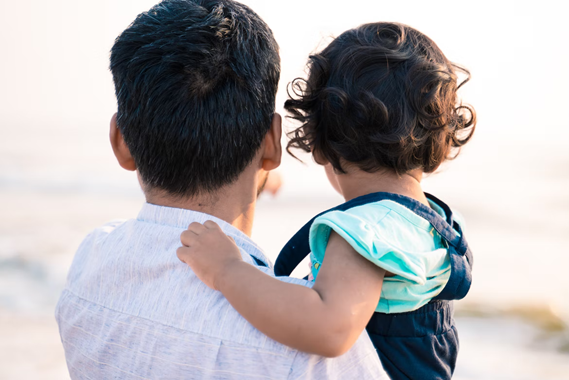13.3.6: Strategies that Support Language Development-Joint Attention
- Page ID
- 140682
Joint Attention
Joint attention refers to a shared focus between a caregiver and a child (including gaze, pointing, and visual attention). Joint attention is an important feature of language development because once joint attention is shared, the caregiver and child have a communicative context in which information about objects or events in the environment can effectively be communicated. [1]

During the child’s first two years of life, joint attention is thought to emerge gradually in interaction with the child’s emotional and social development, as well as resulting from cognitive development involving skills like processing, attention and self-regulation (Morales et al., 2000). Already in the first four months of life, infants start to engage with their caregivers in sustained periods of face-to-face or mutual eye gaze (Johnson & de Haan, 2011). Between the ages of 9 to 12 months, children start to explore their environment more. At this point, dyadic attention shifts to triadic attention in which caregiver and child start to coordinate and systematically divide their attention between objects or events in the environment and with each other (Carpenter et al., 1998; Wille, Van Lierde & Van Herreweghe, 2019). It should be noted, however, that these episodes of triadic joint attention do not occur frequently until children are about 15 to 18 months old (Carpenter et al., 1998). [1]
Joint attention is related to language development. Children’s ability to respond to bids of joint attention by their caregiver at 6, 8, 10, and 18 months of age has been reported to predict vocabulary size at 30 months of age (Morales et al., 2000). Interestingly, there is also some evidence suggesting that responding to joint attention may be predictive of receptive vocabulary size and that initiating joint attention may be predictive of expressive vocabulary size (Markus et al., 2001; Mundy, Fox & Card, 2003; Mundy & Gomes, 1998). Gaze-following behavior at 10 to 11 months predicted receptive vocabulary at both 14 and 18 months (Brooks & Meltzoff, 2005). Further, full-term infants' responsiveness to gaze alternations in triadic interactions at 9 months and initiating triadic interactions at 14 months were positively correlated with later language, such that infants with more responsivity to gaze shifts had better receptive and expressive language scores at 30 months (De Schuymer et al., 2011). Individual differences in responding to joint attention at 9 and 12 months and initiating joint attention at 18 months predicted 24-months expressive language (Mundy et al., 2007). [4] [3]

One reason joint attention is related to language development is because shared attention toward an object allows for language to be more easily mapped to objects. For example if a caregiver and an infant are jointly attending to the same object, such as a dinosaur, when the caregiver uses the word “dinosaur” it creates a clear link between the object (dinosaur) and its linguistic label.
Although engaging in joint attention is a natural activity for caregivers, it does require an investment of uninterrupted time to truly engage with infants and toddlers. So much of a caregivers’ time can be devoted to care routines, preparation and cleaning, it can be a challenge to set aside time for joint attention to take place. For joint attention to occur, caregivers must be fully present in their interactions with children as they share joint attention through eye gaze, visual attention and pointing, oftentimes accompanied with physical touch and language. One study found that across 200 toddlers recorded for twenty minutes while attending group care programs, one third of the children did not engage in any joint attention with caregivers (Smith, 1999). When caregivers practice reading the communicative cues and practice engaging in joint attention with infants and toddlers, they improve in their ability to share in joint attention with children (Cain, Rudd & Saxon, 2007; Gouri-Guberman, 2015; Rudd, Cain & Saxon, 2008). One reason joint attention may be beneficial is that it increases the amount of time infants pay attention to something, such as an object. During moments of joint attention, caregivers can increase an infant’s attention by talking about and manually manipulating the object an infant is interested in (Suarez-Rivera, Smith & Yu, 2019).
[1] Lammertink et al., (2022). Joint attention in the context of hearing loss: A meta-analysis and narrative synthesis. Journal of Deaf Studies and Deaf Education, 27(1), 1-15. CC by 4.0
[2] Image by Kenny Krosky on Unsplash.
[3] Çetinçelik et al., (2021). Do the eyes have it? A systematic review on the role of eye gaze in infant language development. Frontiers in Psychology, 11, 3627. CC by 4.0
[4] Image by Praveen kumar Mathivanan on Unsplash.

